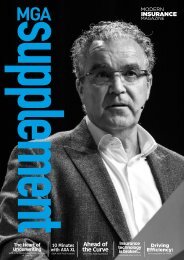Modern Law Magazine Issue 69
You also want an ePaper? Increase the reach of your titles
YUMPU automatically turns print PDFs into web optimized ePapers that Google loves.
EDITORIAL<br />
BOARD<br />
Adrian Jaggard,<br />
CEO, Taylor Rose MW<br />
Bronwyn Townsend,<br />
Senior Marketing Manager,<br />
InfoTrack<br />
Leading Client-Centric<br />
Legal Innovation<br />
Customer feedback is valuable and can be used to improve<br />
your law firm cheaply and effectively. My advice is to keep<br />
your strategy simple and execute fantastically through capture,<br />
feedback, and accountability.<br />
At Taylor Rose MW, we place a strong emphasis on welcoming<br />
and actively seeking feedback from our clients. We firmly<br />
believe that genuine feedback is essential for evaluating our<br />
processes and service delivery. Feedback tells you where there<br />
are individual cases or themes of dissatisfaction. These can be<br />
because of poor performance, overburden, or even a failure to<br />
adapt to changing client expectations.<br />
When collecting feedback, it’s best to utilise various feedback<br />
channels as offering multiple avenues to clients means that<br />
we can cater to the preferences and needs of our clients,<br />
ensuring that the feedback collected is accessible, convenient,<br />
and inclusive. For instance, at Taylor Rose MW we use<br />
multiple review platforms, a feedback widget on our website<br />
and customer feedback surveys enabling us to listen to our<br />
clients and make informed decisions and drive continuous<br />
improvement.<br />
To ensure that we effectively capture and respond to client<br />
feedback, we have an empowered and award-winning client<br />
care team who have the resources and passion to listen to<br />
our clients’ voices. Client care will shine a spotlight on our<br />
shortcomings if needed, engaging with legal services teams on<br />
an equal footing. They challenge themselves to anticipate and<br />
reflect LEO outcomes, monitoring all outcomes against theirs.<br />
Feedback and agreed actions are followed through, process<br />
management remains in Client Care and escalation occurs<br />
whenever needed.<br />
This team not only celebrates excellence but also works<br />
diligently to implement necessary changes and redesign internal<br />
processes to better serve our clients.<br />
In summary, in today’s legal landscape, successful firms<br />
understand the importance of listening to their clients and using<br />
their feedback to drive meaningful improvements. By embracing<br />
a culture of continuous feedback and improvement, we are able<br />
to stay agile, responsive, and better equipped to meet the everchanging<br />
needs of our clients.<br />
Client experience in<br />
conveyancing: getting it<br />
right from the start<br />
First impressions have a lasting impact, so getting client<br />
interactions right from the start is essential. In conveyancing, the<br />
way you onboard clients can considerably influence every step<br />
of the client experience. The thing is, when you get the client<br />
experience right, it usually improves the experience of your team<br />
too.<br />
Data from the new Digital Conveyancing Maturity Report 2024<br />
revealed that an encouraging 76% of firms are now using digital<br />
ID checks during client onboarding, but only 46% have digitised<br />
their TA property information forms. The disconnect here can lead<br />
to some friction in the onboarding process, especially as clients<br />
expect more access to online services.<br />
The report highlighted that technology use in the onboarding<br />
process was on the up, but the progress was slower than<br />
expected. Conveyancing saw a massive boost in digital<br />
onboarding during the pandemic when it was the only way to<br />
manage business as usual, but its momentum has tapered off<br />
since 2022.<br />
Firms have also mentioned client frustration around having to<br />
supply information multiple times throughout the home moving<br />
process. Sure, some of that can’t be resolved until centralised<br />
ID checks are accepted for example, but there are other ways<br />
to minimise how many times your client perceives they need to<br />
provide information, without cutting corners.<br />
If you’re already using digital ID checks or source of funds<br />
verification, it just makes sense to digitise your client onboarding<br />
questionnaires and TA forms too. Take that another step further<br />
and bring all those key onboarding tasks into a single clientfriendly<br />
portal. Not only will you be sending them one request<br />
for information for everything you need in one place, but systems<br />
like these can also take care of chasing onboarding information<br />
with automated reminders.<br />
Portals like these can also flag missing information and prevent<br />
submission of forms or information before it’s completed,<br />
meaning you don’t need to chase for missing details, and your<br />
client can see what is required from them from the start.<br />
Technology can go a long way to supporting the client experience<br />
as well as reducing administrative burden on your staff. So,<br />
if you’re part of the 20% of firms who still rely on post in the<br />
onboarding process, there’s never been a better time to digitise<br />
your client onboarding for a more enjoyable (and faster)<br />
experience for all.<br />
23
















